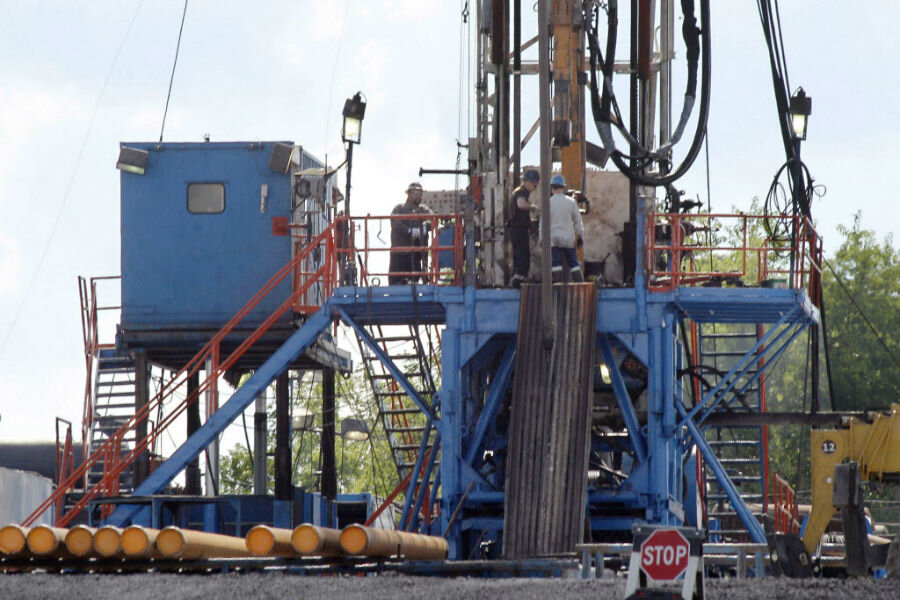Natural gas's green image could be hot air, say scientists
Loading...
Natural gas may not be of much use as a “bridge” fuel en route to achieving significant cuts in greenhouse-gas emissions unless its use is accompanied by rigorous policies aimed at curbing emissions – policies that some analysts say should be designed to harness gas as an ally of renewable-energy sources, rather that as a competitor.
That is the implication of a new study analyzing the effect of globally abundant natural gas on competing energy sources and on greenhouse-gas emissions. The global abundance would result from the use of techniques such as hydraulic fracturing to tap so-called “unconventional” sources of natural gas worldwide.
Assuming that no new climate policies are adopted beyond those that are in place today and that market forces continue to determine the price of gas, an international team of researchers found that gas would replace coal – a help in curbing the emission of greenhouse gases, since natural gas releases about half the carbon dioxide coal does per unit of energy produced.
That's well-established, acknowledges Haewon McJeon, a staff scientist at the Joint Global Change Research Institute in College Park, Md., and the lead author of the study, which is set to appear in Thursday's issue of the journal Nature. Indeed, the move by utilities in the United States to substitute gas for coal contributed to a decline in US greenhouse-gas emissions from 2007 to 2012.
However, "in the absence of climate policies, abundant gas alone is not going to solve climate change," Dr. McJeon says.
The reason: Globally gas would become so abundant and cheap, “it's not going to just displace coal, but it's also going to displace other energy sources, such as wind, which is practically carbon-free,” he says. The emission-reduction gains from avoiding coal are offset by a slowdown in the adoption of renewable sources.
That's where policies come into play. For instance, “you can imagine a policy similar to renewable portfolio standards, for example, where gas is forced just to displace coal,” McJeon says.
Another approach, suggested by analysts at Citi Research, a division of Citigroup Global Markets Inc., would relegate gas to a supporting role [for] to renewables. Under that model, gas-fired power plants would provide the additional electricity needed to meet demand only during times when wind or solar sources are least productive.
Indeed, a back-up role for gas “is possible because small gas plants are relatively cheap to build when compared to other options for large-scale energy storage,” which renewables such as wind or solar power would require to fill their gaps, says Steven Davis, a climate-policy specialist at the University of California at Irvine.
The study by McJeon and colleagues grew out of an international workshop held at the Joint Global Research Institute last year looking at the global impact of new technologies for finding and extracting oil and gas from once-shunned underground rock formations.
The workshop was taking place against a larger backdrop of conflicting research that gas could play a key role in making the transition to carbon-free or carbon-neutral energy sources, while other studies found that methane leaks from gas-production facilities alone would blunt natural-gas's impact on reducing emissions. Molecule for molecule, methane is a more-potent greenhouse gas than carbon dioxide, although it has a shorter residence time in the atmosphere.
“Most of the studies at the time looked at a short-term, US effect” from the increased use of natural gas, McJeon says.
Other modelers attended the workshop who had been crunching global, longer-term numbers. When they got together to compare notes, they found they each had independently concluded that the abundance of gas alone would not slow climate change without targeted policy. For good measure, the group enlisted others to run the same scenarios, bringing the number of independent modeling groups to five.
The team's estimates pointed to an increase in natural-gas consumption of up to 170 percent by 2050 over consumption of gas purely from conventional sources – the low-abundance track. In the absence of additional, explicit energy policies, the models found a comparatively small change in the global emissions trajectory, ranging from a 2 percent decline to a 7 percent increase by mid century over the low-abundance trajectory.
When the team included a scenario in which gas was only allowed to substitute for coal, all but one model yielded emission reductions that ranged from 0.1 percent to 6 percent.
The study's results “are quite reasonable,” notes Richard Newell a professor of energy and environment economics and director of Duke University's Duke Energy Initiative in Durham, N.C., in an email.
Earlier this year, he and colleague Daniel Raimi published a study on the impact of shale-gas extraction in the US on emissions.
“We found that while natural gas can reduce greenhouse emissions when it is substituted for higher-emission energy sources, abundant shale gas is not likely to substantially alter total emissions without policies targeted at greenhouse gas reduction,” he writes.
While studies showing that of itself, natural gas is no silver bullet in the battle against human-triggered global warming, it's a message worth repeating, suggests the University of California at Irvine's Davis.
Currently emissions globally are following a business-as-usual scenario, placing the world on an emissions track that in effect typifies one that results from no new policies, despite efforts to adopt them.
Moreover, Davis says, the power plants built today will be on line, producing emissions, for decades. Scaling gas back to a supporting role while increasing the role for renewables is important for developed countries as well as developing nations that in many cases have yet to provide electricity to 1.3 billion who now lack it.
“If they follow that very fossil intensive path, whether gas or coal, it will not be a good thing from a climate perspective,” he says.







